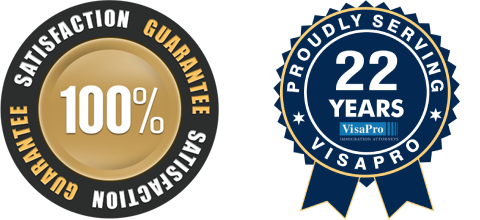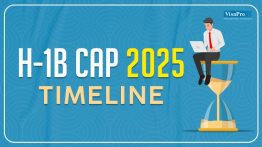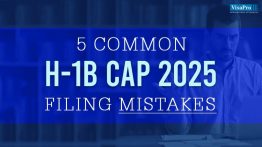Introduction
For the majority of professionals and managers coming to work in the United States, both the H1B and L1 visa categories are popular work visa options.
The requirements and features of the H1B visa and L1 vary greatly and a clear understanding of these differences will help determine which visa is most suitable for your situation.
The H1B Visa And L1 Visas – What Are They?
1. H1B Visa
Allows U.S. employers to employ a foreign professional to work in a “specialty occupation” for a period of up to six years.
2. L1A Visa
Allows qualified employees of an international company to be transferred to a related company in the U.S. in an executive or managerial capacity.
3. L1B Visa
Allows employees of an international company to be transferred to a related company in the U.S. because he or she has “Specialized Knowledge”.
Employers and applicants often wonder what really differentiates the H1B and L-1 visa categories and what one must consider when evaluating which of the two options is more suitable in a given situation.
Consider the case of Martin below:
My Case Scenario
Martin
Martin is an HR manager at a multinational company in the U.S. His company recently identified a Business Analyst who they want to employ. The candidate is from South Korea and is in the U.S. on H1B status. Martin is asked to check for and fulfill any visa formalities. The foreign national had worked with one of the company’s affiliates in Hong Kong for about 18 months before moving to U.S. on an H1B for a different company. He is now looking for a change and Martin’s company is eager to bring him back.
When Martin made inquiries with his peers to identify a suitable visa category in this situation, he came across the H1B and L-1 visa categories. While most suggested an H1B transfer for a quicker process, a few suggested the L-1 to avoid prevailing wage requirements, leaving Martin thoroughly confused.
In determining the best visa option, the needs of the employer as well as the background of the beneficiary are important considerations.
To determine which is the best option in a given situation, we present here:
The 15 Essential Differences Between The H1B And L1 Visa Categories
1. Foreign National’s Education Qualification
H1B Visa: The foreign national must have at least a U.S. bachelor’s degree or its equivalent.
L1A Visa and L1B Visa: There are no minimum educational requirements.
IMPORTANT
To determine degree equivalency, USCIS will accept three years of progressive, qualifying work experience for each year of missing university education to determine equivalence to a four-year bachelor’s degree.For the L1B Visa, USCIS may, in certain circumstances, question whether a candidate actually possesses “Specialized Knowledge” without possessing a certain degree.
2. Foreign National’s Prior Work Experience
H1B Visa: There is no minimum work experience requirement.
L1A Visa and L1B Visa: The foreign national must have worked in a related company outside the U.S. for at least one year in the three years preceding his/her entry into the U.S.
DID YOU KNOW?
For a “qualifying” relationship to exist between the U.S. Company and the foreign Company for L-1 purposes, the U.S. Company must be a parent company, branch, subsidiary or affiliate of the foreign Company.
3. Requirements For The U.S. Position
H1B Visa: A bachelor’s degree or its equivalent in a specific field must be the minimum requirement for entry into the position.
L1A Visa: The position offered in the U.S. must be as a manager or executive.
L1B Visa: The position offered in the U.S. must require a person with specialized knowledge.

4. Foreign Company Requirement
H1B Visa: The U.S. employer is not required to be related to any company outside the U.S.
L1A Visa and L1B Visa: The related foreign company that employed the foreign national outside the U.S. prior to admission must continue to remain active and doing business during the entire duration of the foreign national’s stay in the U.S. in L1A or L1B status.
IMPORTANT
“Doing business” means the regular, systematic, and continuous provision of goods and/or services by a qualifying organization and does not include the mere presence of an agent or office of the related company in the United States and abroad.
5. Quota Limitations
H1B Visa: An annual numerical limit of 65,000 (“H1B Cap”) is in place on the number of H1B visas that can be issued during a fiscal year.
L1A Visa and L1B Visa: There are no annual numerical limits on the number of L1A or L1B visas that can be issued during a fiscal year.
DID YOU KNOW?
The H1B cap only applies to new H1B applications and does not generally apply to H1B status holders who are seeking extensions or change of employer.
6. Labor Condition Application (LCA)
H1B Visa: An employer must submit a Labor Condition Application (LCA) that has been certified by the U.S. Department of Labor along with the H1B petition.
L1A Visa and L1B Visa: There is no LCA requirement under the L1A or L1B visa category.
DID YOU KNOW?
The Labor Condition Application (LCA) is the Dept. of Labor Form ETA-9035 and is submitted to the Department of Labor electronically through the DOL iCERT website.
7. Prevailing Wage
H1B Visa: The H1B employee must be paid the greater of the actual wage paid to others in the company with similar experience and qualifications for the specific job or the prevailing wage for the occupation in the area of employment.
L1A Visa and L1B Visa: There are no Prevailing Wage requirement under the L1A or L1B visa category.
IMPORTANT
An H1B employer must attest in the LCA filed with the Department of Labor that it will pay the required wage to the H1B worker for the duration of the authorized period of employment.
8. Blanket Provision
H1B Visa: There is no Blanket Provision for H1B. The employer must file an I-129 petition with USCIS on behalf of every individual foreign national proposed to be hired on H1B.
L1A Visa and L1B Visa: The Blanket L provision allows employees being transferred from one qualifying organization to another bypass the USCIS I-129 petition process and proceed directly to the appropriate U.S. Embassy or Consulate abroad to apply for an L1A or L1B visa.
DID YOU KNOW?
The Blanket L provision provides the qualified employer with the flexibility to transfer eligible employees to the United States quickly and with short notice without having to file an individual petition with USCIS.
9. Opening A New Office
H1B Visa: A new U.S. company can use the H1B to hire an individual who will help to establish the newly formed company. The company, however, must be prepared to show that this individual will have sufficient “specialty occupation” work and that a proper “employer-employee” relationship exists between the Company and its employee.
L1A Visa: A foreign company which does not have an established affiliate U.S. office may use the L1A to send an executive or manager to the United States with the purpose of establishing one.
L1B Visa: A foreign company which does not have an established affiliate U.S. office may use the L1B to send a specialized knowledge employee to the United States to help establish one.
IMPORTANT
While seeking an L-1 visa to establish a new office, the employer must be able to demonstrate to USCIS that it has secured sufficient physical premises to house the new office.
10. USCIS Petition Fees
H1B Visa:
- Form I-129 – $325
- Fraud Prevention and Detection Fee – $500 (Only for initial H1B approval for each individual beneficiary)
- ACWIA Fee – $750 or $1500
- Public Law 111-230 Fee – $2000, if applicable.
L1A Visa:
- Form I-129 – $325
- Fraud Prevention and Detection Fee – $500 (Only for initial L1A approval for each individual beneficiary)
- No ACWIA Fee
- Public Law 111-230 Fee – $2250, if applicable.
L1B Visa:
- Form I-129 – $325
- Fraud Prevention and Detection Fee – $500 (Only for initial L1B approval for each individual beneficiary)
- No ACWIA Fee
- Public Law 111-230 Fee – $2250, if applicable.
DID YOU KNOW?
1. Certain H1B petitioners, including institutions of higher education, nonprofit research organizations, governmental research organizations, primary or secondary educational institutions, and nonprofit entities that are either related to or affiliated with an institution of higher education or that engage in an established curriculum-related clinical training program for students, are exempt from ACWIA fee.
2. H1B petitioners are also exempt from the ACWIA fee when filing a 2nd or subsequent extension of stay petition for a foreign worker.
3. The Public Law 111-230 fee is an additional fee payable only by employers who employ 50 or more individuals in the US and where more than 50% of those employees are in H1B or L status.
11. Maximum Period of Stay
H1B Visa: Total maximum period of stay is 6 years which can be granted in no more than 3-year increments. L-1 time will count against total allowable H1B time.
L1A Visa: Total maximum period of stay is 7 years which is generally granted for up to 3 years initially and extensions granted in 2-year increments. Individuals coming to a New Office are only granted 1 year initially. H1B and L1B time will count against total allowable L1A time.
L1B Visa: Total maximum period of stays if 5 years which is generally granted for up to 3 years initially and extensions granted in 2-year increments. Individuals coming to a New Office are only granted 1 year initially. H1B and L1A time will count against total allowable L1B time.
IMPORTANT
A foreign national who has previously held H1B or L-1 status can get a new 6 years of H1B by going through the H1B Cap again or be eligible for 7 or 5 years in L1A or L1B time respectively, if he or she remains outside the U.S. for one continuous year.H1B visa holders may be eligible for extensions beyond the 6-year maximum if an employment-based permanent residence application is pending or has been approved on their behalf.
12. Work Permit For Spouse
H1B Visa: A spouse of an H1B visa holder in H-4 status may not accept employment in the U.S.
L1A Visa and L1B Visa: A spouse of an L1A or L1B visa holder in L-2 status may be eligible to seek employment authorization to work in the U.S.
IMPORTANT
Spouses of L-1 workers may apply for work authorization by filing a Form I-765, Application for Employment Authorization, along with the prescribed fee.If approved, there is no specific restriction as to where the L-2 spouse may work.
13. Payroll
H1B Visa: The foreign national must be on the payroll of the U.S. employer. A valid employer-employee relationship must exist between the U.S. employer and the foreign national employee.
L1A Visa and L1B Visa: The foreign national may be on the payroll of the U.S. employer and/or the foreign company.
DID YOU KNOW?
Both the H1B and the L-1 visa categories support the notion of ‘Dual Intent’ meaning a foreign national can enter and remain in the U.S. lawfully on an H1B or L-1 visa category even while having immigrant intent and/or not actually maintaining a foreign residence at the same time.
14. Changing Employers – ‘’Portability”
H1B Visa: H1B portability provisions allow a foreign national in H1B status to begin working for a new H1B employer as soon as the new employer files an H1B petition for him or her without having to wait for USCIS approval of the petition.
L1A Visa and L1B Visa: A foreign national in L1A or L1B status can work only for a qualifying member of the multinational group (parent, subsidiary, sister, branch, or affiliated company) that filed the petition. He or she will not be able to work on a new L-1 for a company that is not a qualifying member of the multinational group.
IMPORTANT
For the L-1 visa, a new I-129 petition must be filed if the petitioning entity changes.A new I-129 petition does not have to be filed if the employee entered on a Blanket L-1 and the move is to another entity listed on the Blanket L.
15. The Path To Green Card
H1B to Green Card: Most H1B visa holders would require a labor certification filed on their behalf through the Department of Labor to be eligible for the Green Card.
L1A to Green Card: L1A visa holders may be able to apply for an expedited Green Card in the EB-1C category and waive the labor certification process.
L1B to Green Card: Most L1B visa holders would require a labor certification filed on their behalf through the Department of Labor to be eligible for the Green Card.
An L1B visa holder may be eligible for an expedited green card in the EB-1C category if he or she was in a managerial or executive role before coming to the U.S. and is being sponsored for an executive or managerial position.
IMPORTANT
Once the Green Card process is initiated, an H1B visa holder may be able to extend their stay in the U.S. beyond the sixth year if the labor certification or I-140 has been pending for at least 365 days or an approved I-140 is retrogressed.Employers who have L1B visa holders who need to remain beyond the 5th year will need to consider changing their status to L1A or H1B.
My Case Scenario
Martin
After careful consideration and detailed discussions with immigration attorney, Martin decided that the company should bring the foreign national back into the company through the H1B transfer process. Since the candidate was already in H1B status and could benefit from portability and his offered salary was well above the prevailing wage, the H1B process would most likely be the faster and more straightforward of the two visa options.
Conclusion
While both the H1B and the L1 work visa categories are suitable for most professional positions, their features and requirements vastly differ. Identifying the right visa category that meets the intended purpose requires a comprehensive review of the circumstances, and doing so will increase your chances of securing approval.
Contact VisaPro Law Firm today for a FREE Visa Assessment to determine the most appropriate visa type for your situation. We’ll analyze your scenario and recommend an effective strategy based on our attorneys’ near 100% success rate.
What VisaPro Customers Are Saying
Knowledgeable, fast, courteous, efficient are all words that describe the services I received from VisaPro. They were very helpful in all phases of the H-1B visa process and they got it right the first time. I have tried other Visa services, but VisaPro is the best by far. VisaPro is the only way to go!"

 Raymond Meyers, President, EBOZ, Inc
Raymond Meyers, President, EBOZ, Inc



